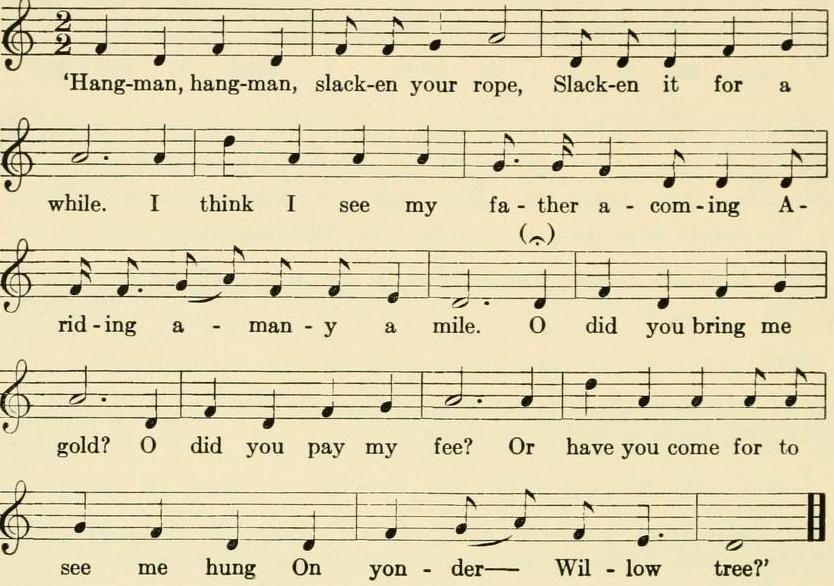True Love- McCauley (NC) c.1877 Brown H
[From the Brown Collection of NC Folklore, II, 1952 and Volume IV, music. Listed as 30. The Maid Freed from the Gallows (Child 95).
Their notes follow.
R. Matteson 2015]
For preceding records of this ballad and its relation to theories of communal origin, see BSM 66, adding to the references there given New Hampshire (NGMS 117-18), Kentucky (BTFLS in 95), Tennessee (SFLQ XI 129-30), North Carolina (FSRA 35-6), Florida (FSF 295-9), Arkansas (OFS I 146-8), Missouri (OFS I 143-4, 145), Ohio (BSO 62-4), Indiana (BSI 125-7), and Michigan (BSSM 146-8 — this last being the "golden ball" form, rare in this country). In only half of the North Carolina texts is it a woman that waits to be freed from the gallows ; in versions B C E K L it is a man, and in D the sex is indeterminate. D is the only one of our texts in which the song has been turned into a play.
H. 'True Love.' Reported by Mrs. R. D. Blacknall of Durham as sung by the Misses Holeman in July 1922. They had learned it from the singing of a "negro servant, Maria McCauley, presumably ex-slave of the Chapel Hill McCauleys. Heard forty-five years ago." The series is father, mother, brother, sister, true love. Ends:
'O did you bring me gold?
O did you pay my fee.
Or have you come for to see me hung
On yonders willow tree?'
O I did bring you gold,
And I did pay your fee.
And I have not come for to see you hung,
For that thing it never shall be!'
_______________________________
H. 'True Love.' Sung by Miss Jean Holeman. Recorded at Durham in July 1922, Other titles given are 'Maid Freed from the Gallows' and 'Hangman, Hangman'. The first four measures are the initial phrase of 'lam Christus astra ascenderat,' which is a Whitsuntide church melody from the eleventh century. The same tune is also used in the German hymn 'Christ der du hist der helle Tag,' which dates from 1568. As our singer changed the melody for the second stanza, "Oh did you bring me gold," the two stanzas are given consecutively.

For melodic relationship cf. ***SFSEA 159, No. 142, measures 8-10, and 237, No. 245, measures 1-4 with our measures 9-12. **SharpK i 162, No. 28B, measures 5-6, melodic tendency only.
Scale: Pentachordal. Tonal Center: d. Structure: (ist stanza) abed (2,2,2,2); (2nd stanza) b1b2c1d1 (2,2,2,2).